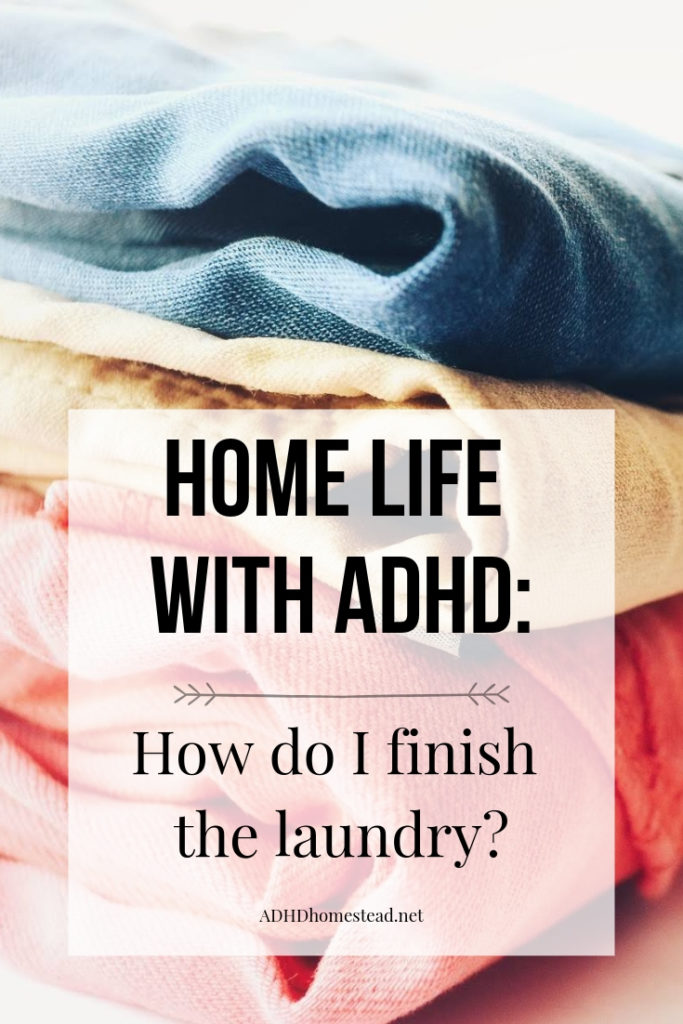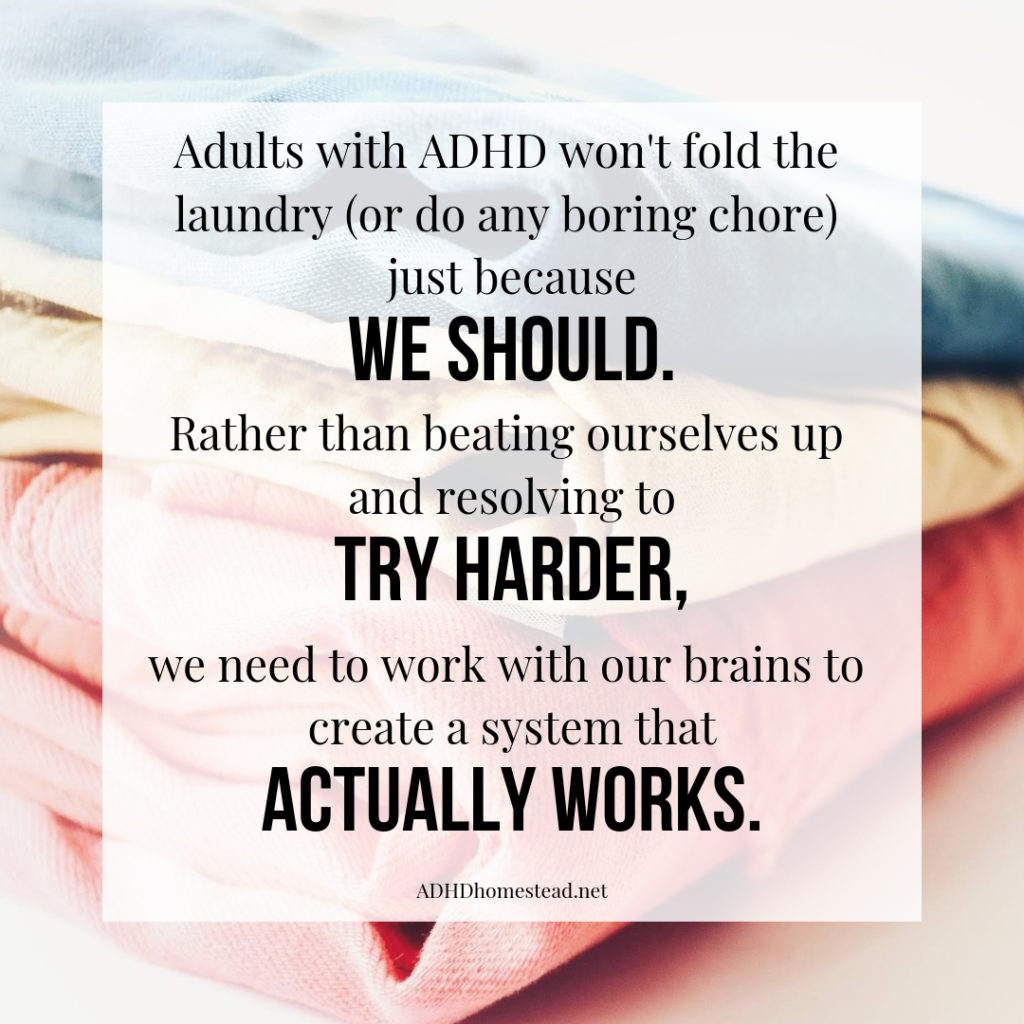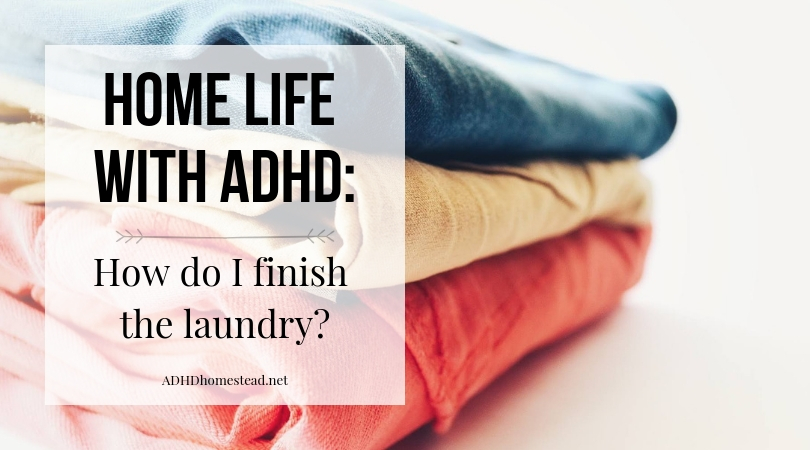Following my post about tackling those pesky lingering items on your to-do list, a reader wrote to me with a question about laundry.
I don’t struggle to actually put it in the washer and dryer, but when it comes to putting it away I’m stuck. I currently have three baskets of clothes in my bedroom and closet. I just wear clothes out of [them] until I can combine two baskets and use the empty one to wash more clothes. Any tips on getting laundry put away in a timely fashion? Thanks! – S
Sound familiar? Almost all of us have been there. I’ve featured unpleasant chores (and how to make yourself do them) in a previous ADHDgram tip of the month, but today we’ll look at this pesky issue in more detail.
The short answer: yes, I do have some advice. But it also helps to understand why we ADHDers struggle so hard with basic chores.

You already have a working system.
Yes, you heard me correctly. S already has a system for laundry — and it’s working. The laundry gets washed and returned to a convenient location on a regular basis. S may not feel satisfied with the process, but it works at a basic level. This 80% solution is where a lot of ADHDers get stuck.
That’s because we so often use crises and deadlines as motivators. We leave a project until the last minute, then finish it in a panic. We get distracted scrolling through our phones, then realize we need to race to pick our kids up at school. And many of us put off doing the laundry until we notice we’re down to our last pair of clean underwear. Then, suddenly, we find the motivation to do it.
But once it’s clean, then what? The emergency has passed. We can’t seem to force ourselves to finish the job. As a kid, I got in trouble all the time for leaving my clean laundry in the dryer. I’d retrieve items from there as I needed them — until someone else wanted to use the dryer and my stuff got in the way.
This is a classic ADHD problem: if the task doesn’t interest us and it doesn’t feel like an emergency right now, we avoid doing it.
And yet, we need to fix it.
Just because a system is working doesn’t mean it feels right. Clearly, S wants a more organized laundry routine: one where they wash the clothes, fold them, and put them away within a reasonable amount of time. Because that feels like the right thing — the adult thing — to do.
Some organizing experts recommend that you not allow yourself to call the job finished until you’ve put the clothes away. In other words, don’t check “wash laundry” off your list until the clothes are back in your closet or dresser. Eventually, you’ll condition your brain to include folding and putting away in its definition of washing the laundry.
Except that you can’t fool your brain. You know you’ll have clean clothes to wear even if you don’t put them away. You can’t conjure motivation out of the ether simply by telling yourself “this job isn’t done until I put the clothes away in the drawers.”
Figure out why you want the process to be different.
The first step in retraining yourself and pushing this 80% to 100% is to figure out why change matters. I spend an entire section of Order from Chaos talking about this. It can make or break your attempts to improve your life.
We all know what we should do. And maybe some people can motivate themselves to do uninteresting or unpleasant tasks simply because they should. Those people most likely don’t have ADHD.
If you really want to put the laundry away, figure out why that feels like an important thing to do. Go deeper than “because responsible adults know how to put their laundry away.” Your reasons might include something like:
- I feel embarrassed when I have someone over and they see all my laundry sitting out. I want to feel more comfortable inviting guests to my house.
- When my bedroom looks tidy, I feel much more calm and centered. I want this room to be a relaxing space for me — somewhere I can retreat.
- My wrinkled clothes are affecting my confidence at work. I want to look and feel more put together so I can put my best foot forward and live up to my potential.
Once you’ve tied fixing this specific problem — putting away clean laundry — to a deeper goal that sits close to your values or identity, remind yourself of it often. You may even want to put a picture representing this goal near where the laundry sits to remind you of what lies on the other side of your efforts.

Make the work as fun and easy as possible.
There’s no getting around the fact that we ADHDers abhor tedium (unless, of course, it’s a task that engages our hyperfocus). No matter how much you want to change your habits, it will still feel nearly impossible to initiate a boring task.
Think about how you think — and adapt your system accordingly.
Your thinking and learning style should inform how you organize your stuff. I wrote a guest post about this for A Dose of Healthy Distraction, which I highly recommend to anyone more interested in this topic.
In short, your ADHD already makes you feel like you’re fighting your brain every single day. Getting organized is hard. Don’t add another layer of difficulty by forcing yourself to use tools that conflict with your thinking style.
This is especially important if you’re what we call a visual thinker. My husband is a visual thinker. It took me a long time to figure out why he rarely put anything away in our home: his brain resists putting things out of sight. This explains why visual thinkers do so much better with baskets than with closed drawers and cabinets.
If you’re a highly visual person, you might consider alternatives to the standard out-of-sight clothing storage. I’ve seen people stack clothing neatly on IKEA Kallax shelves. I’ve seen rolling garment racks stored in a corner of the room. For some people, finding an attractive way to store things in plain sight makes it easier — or even possible — to put those things away.
Find a way to make it fun.
I usually wash our entire household’s clothing, towels, sheets, rags, and napkins once weekly. This amounts to 3-5 big blue IKEA bags. I’ve never looked at this and thought, wow, I can’t wait to get started. More often, I feel like I have an invisible force field pushing me away from the task.
To combat this, I try to connect boring or unpleasant jobs with a fun activity. Bonus points if it’s something I feel I don’t have enough time for.
In the case of the laundry, I watch TV. I have trouble sitting still or making time to watch television, even though I love to immerse myself in a well-written show. Folding laundry gives me both a fidget and an excuse to watch TV. I’ve made a rule for myself that except on special occasions, I won’t only watch TV: I have to be doing something else, too. I have a whole section of my to-do list dedicated to stuff I can do on the couch while I watch a show.
If you don’t want to give up unencumbered TV time, choose one show that you’ll only watch while folding laundry. Or try another favorite of mine: podcasts. I love podcasts, but never have time to listen to everything on my list. I’ve also created special music playlists for chores I don’t enjoy.
Whatever activity you choose to do while you fold — it could even be calling a friend or family member on the phone — make sure it’s something that will bring you joy and help you look forward to the task. Try to make it something you wouldn’t be doing anyway.
Find your Why, troubleshoot the How.
Bottom line: chores can be complicated for people with ADHD. What others seem to do on autopilot, we have trouble doing at all. These struggles can turn into bigtime character judgments.
Instead of focusing on how frustrated you feel with yourself, figure out why this chore feels like an important task to get done — and go beyond “because it needs to.” You know that already and it hasn’t helped yet. The trick is to figure out what part of your core identity and values will feel supported by your success with this chore.
Once you know why you want to do better — not why you should or why your spouse wants you to — you need to get to know yourself. Get acquainted with your brain. Work with your natural tendencies, not against them. Take a problem-solving approach instead of a try-harder approach. Think of these problems like a machine that has broken down: you need to find the broken part and repair it, not tell the machine to work harder. Same goes for your organizational systems.
When something isn’t working, there’s usually a reason. The only way to get the thing running smoothly is to figure out that reason, adjust, fail, assess, adjust, fail, and adjust again until it clicks. Does it feel good to have to troubleshoot our laundry like this? No. But when we walk into an orderly bedroom and know we only have our own hard work to thank, the reward is sweet.
Hey there! Are you enjoying The ADHD Homestead?
Here's the thing: I don't like ads. I don't want to sell your attention to an advertising service run by the world's biggest data mining company. I also value my integrity and my readers' trust above all, which means I accept very few sponsorships/partnerships.
So I'm asking for your support directly. For the cost of one cup of coffee, you can help keep this site unbiased and ad-free.
Below you will find two buttons. The first lets you join our crew of Patreon pals and pledge monthly support for my work. Patrons also have access to my Audioblogs podcast. The second takes you to a simple donation page to pledge one-time or recurring support for The ADHD Homestead, no frills, no strings. Do whichever feels best for you!

